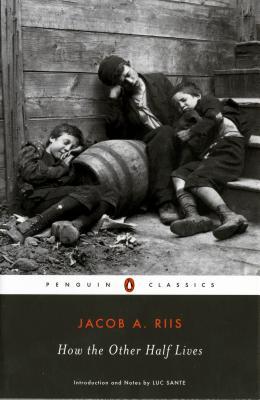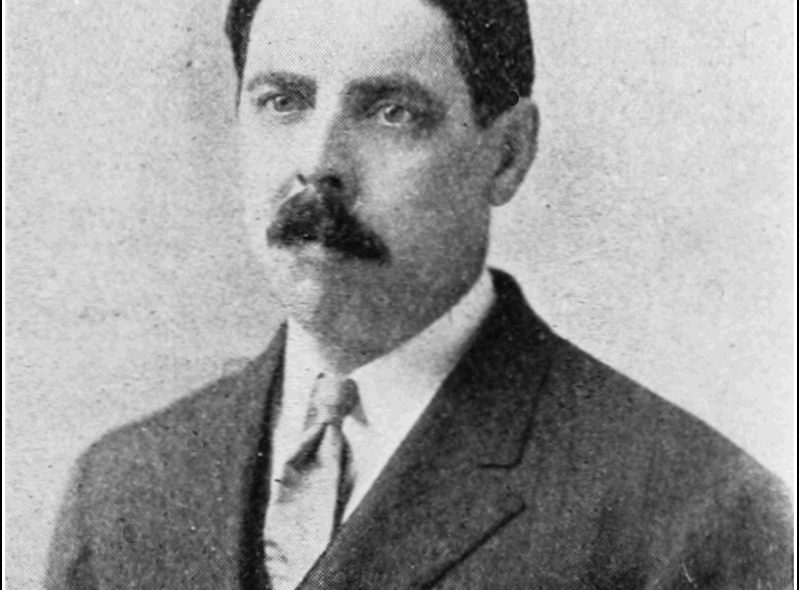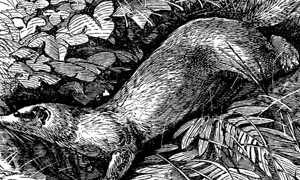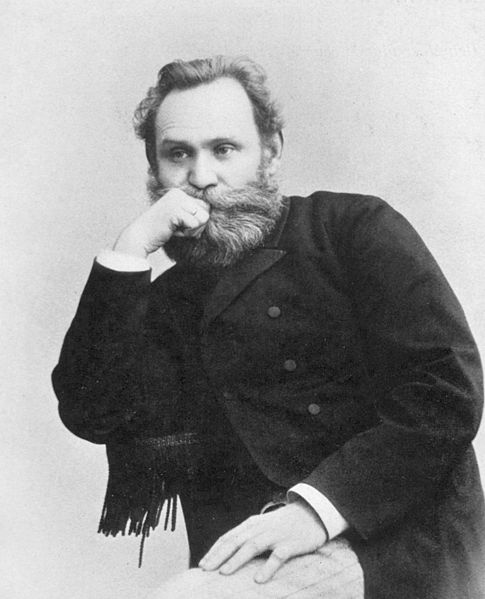With May 26th having marked the 100th anniversary of the death of Jacob Riis, the Danish social reformer and journalist of the late nineteenth century, it seemed appropriate to feature Riis’ most prominent work, How the Other Half Lives, as 17th Street’s first “book blog” for June. In the New York Times web chat Caleb Carr gave early last year, he cited How the Other Half Lives as one of his most important influences for The Alienist, stating that “very little can beat” it as a contemporary source of information about life in nineteenth century New York. Indeed, readers of The Alienist should already be at least vaguely familiar with Riis thanks to the cameo he received in the novel itself–even if our protagonist, Dr. Laszlo Kreizler, wasn’t terribly fond the crusading Dane.
The Alienist, Chapter 5:
Riis came huffing up behind Steffens, his hulking Danish frame not so lithe as that of the much younger Steffens. “Doctor,” he said, to which Kreizler only nodded. He had a positive dislike for Riis; the Dane’s pioneering work in revealing the evils of tenement life–most notably through his collection of essays and pictures called How the Other Half Lives–did not change the fact that he was a strident moralist and something of a bigot, so far as Kreizler was concerned. And I have to admit, I often saw Laszlo’s point.
What’s it about?
How the Other Half Lives, “Introduction”:
Long ago it was said that “one half of the world does not know how the other half lives.” That was true then. It did not know because it did not care.
These famous lines, referencing François Rabelais’ Pantagruel, open Jacob Riis’ How the Other Half Lives, a short but powerful piece written as an agent for change. In the Introduction to the 1997 Penguin edition, Luc Sante (the author of Low Life, another of Caleb Carr’s cited inspirations) wrote that, “How the Other Half Lives is one of those unusual books that changed history in a material way, directly affecting the lives of millions of people.” This pioneering work, first published in 1890, combined photography, narrative essays, and hard statistics to take the reader on a journey into the slums of New York City in the late 1880s. Although others had previously shed light on the conditions of the poor in New York City, by focusing on immediate, practical problems, and presenting solutions, Riis was able to make an impact in a way his predecessors had not. Notably, even Theodore Roosevelt would find Riis’ work a source of inspiration, and he went on to count Riis as his “main prop and comfort” during his tenure as Police Commissioner several years later; when TR first read How the Other Half Lives, he left his card for Riis at the latter’s Evening Sun offices with the words, “I have read your book and I have come to help.” written on the back.
How the Other Half Lives opens with a brief history of the tenement, ranging from its earliest days in the first half of the nineteenth century when once fashionable single-family dwellings on the East River front had their rooms partitioned to meet growing demands from the city’s steadily increasing workforce, to the multi-story tenements we associate today with New York City of the late nineteenth century; tenements that were built in such numbers that, according to Riis, “on the East Side, in what is still the most densely populated district in all the world, China not excluded, it was packed at the rate of 290,000 to the square mile, a state of affairs wholly unexampled.” Following this short history lesson, Riis takes his reader on a guided tour through the original downtown back alleys of New York City, focusing much of his attention on the notorious Mulberry Bend, before spending the bulk of his text describing the practices and lifestyles of the major ethnic groups that occupied the tenement districts of the late 1880s: the Irish, the Italians, the blacks, the Chinese, the Polish and Russian Jews, and the “Bohemians” (Czechs and Slovaks).
In the final third of the book, Riis introduces his readers to the children of the street, taking us from their infancy as abandoned or cast out “street waifs”, through their middle years as “street arabs”, before presenting a warning about the adult career they are destined to pursue if they receive no intervention during their youth: becoming the “toughs” of New York’s street gangs. Riis then devotes a chapter to the evils of the saloon, another to the dreadful working conditions of females that would make “almost any door … seem to offer welcome escape from such slavery as this” (a subtle insinuation regarding the “opportunity and danger that prostitution presents to poor girls”, as Luc Sante more bluntly put it in his Introduction), the relative merits and problems charitable solutions pose to the problem of poverty, and finally to the possibilities presented by both simple solutions to the problems of the tenements (e.g., having landlords or competent janitors living in the properties at all times to enforce rules of conduct) and more complex solutions (e.g., the construction of “model” tenements that have proper light and ventilation in place of razed tenements).
My thoughts
Throughout my reading, I didn’t find it difficult to understand why How the Other Half Lives became such a powerful impetus for change in the 1890s, nor did I find it difficult to see why Caleb Carr considered it a valuable reference work while writing the Alienist books. Nevertheless, on more than one occasion I found myself agreeing with Dr. Kreizler about Riis during my reading. As easy as much of the book is to read, I found chapters like “Chinatown”, where Riis’ pious missionary zeal and condescending racial prejudices were apparent on almost every page, particularly hard-going, and I needed to give myself frequent breaks. Take the following excerpt as an example.
How the Other Half Lives, “Chinatown”:
At the risk of distressing some well-meaning, but, I fear, too trustful people, I state it in advance as my opinion, based on the steady observation of years, that all attempts to make an effective Christian of John Chinaman will remain abortive in this generation; of the next I have, if anything, less hope. Ages of senseless idolatry, a mere grub-worship, have left him without the essential qualities for appreciating the gentle teachings of a faith whose motive and unselfish spirit are alike beyond his grasp.
Although one might argue that in holding such opinions Riis was simply a man of his time, as Luc Sante pointed out in his Introduction to the text, “it is noteworthy that one anonymous reviewer, writing in The Critic of December 27, 1890, judiciously expressed the book’s shortcomings:”
His book is literally a photograph and as such has its value and lesson, but also its serious limitations. There is a lack of broad and penetrative vision, a singularly warped sense of justice at times, and a roughness amounting almost to brutality. The “Heathen Chinese” and the Russian Jew fleeing from persecution in his own land, find no mercy in Mr. Riis’ creed.
“This blunt summary shows that Riis’ myopia in regard to cultures more foreign than his own origins was not strictly a function of the times in which he lived.” Moreover, as John explains a little further on in The Alienist, there were noteworthy aspects of slum life, such as homosexual and child prostitution, that were completely missing from Riis’ text; aspects John claims Riis “could not accept” despite “all the horrors he had witnessed”. However, do not suppose by these criticisms that I didn’t find the book an interesting or worthwhile read. I found the sections of the text in which Riis takes his reader on guided tours of the slums, employing a conversational tone that relays sights, smells, and sounds in such a way that the reader is almost there beside him, invaluable; Riis’ prose is not florid or sensationalist in nature, and as such he provides a vivid and realistic snapshot of life in the tenements that is fascinating to read, as the following excerpt from a chapter about life in the Jewtown sweater district demonstrates.
How the Other Half Lives, “The Sweaters of Jewtown”:
It is Sunday evening west of the Bowery … Men stagger along the sidewalk groaning under heavy burdens of unsewn garments, or enormous black bags stuffed full of finished coats and trousers. Let us follow one to his home and see how Sunday passes in a Ludlow Street tenement.
Up two flights of dark stairs, three, four, with new smells of cabbage, of onions, of frying fish, on every landing, whirring sewing machines behind closed doors betraying what goes on within, to the door that opens to admit the bundle and the man. A sweater, this, in a small way. Five men and a woman, two young girls, not fifteen, and a boy who says unasked that he is fifteen, and lies in saying it, are at the machines sewing knickerbockers, “knee-pants” in the Ludlow Street dialect. The floor is littered ankle-deep with half-sewn garments. In the alcove, on a couch of many dozens of “pants” ready for the finisher, a bare-legged baby with pinched face is asleep. A fence of piled-up clothing keeps him from rolling off on the floor. The faces, hands, and arms to the elbows of everyone in the room are black with the colour of the cloth on which they are working. The boy and the woman alone look up at our entrance. The girls shoot sidelong glances, but at a warning look from the man with the bundle they treat their machines more energetically than ever. The men do not appear to be aware even of the presence of a stranger.
Other sections relay distressing accounts of children Riis witnessed dying of starvation, babies abandoned on fire-escapes (reminiscent of the scene in The Alienist where John and Sara nearly step on a baby in a dark tenement hallway), and tales of suicides from immigrants too “tired” to go on. Riis introduces us to workers who developed diseases such as lead poisoning that prevented them from providing for their families, and told bittersweet stories such as that of a young boy who was excited to spend a night in Police Headquarters because he was given a bed to sleep in (he was used to sleeping on “a heap of dirty straw on the floor”) and one egg and three slices of bread for breakfast (“his daily diet [consisted of] a crust in the morning, nothing else”). On top of these snapshots of human life, the overcrowding, pay rate, and death rate statistics Riis provided throughout the text were nothing short of staggering.
Considering the racial prejudices that pervade How the Other Half Lives, it is somewhat ironic that perhaps the most important aspect of Riis’ work was his willingness to tackle another common nineteenth century prejudice held by many in the middle and upper classes; that those who lived in the shocking conditions of the tenements deserved or, worse still, chose their fate. Instead, Riis made it clear how, through no fault of their own, many hard-working immigrants found their way into the tenements and lacked means of escape, as well as stressing the importance of the role of the environment in the creation and perpetuation of problems (e.g., crime) that arose out of the tenements. Granted, as a result of Riis’ unwillingness to enquire with any depth into the origins of the social conditions in the tenements, some of his pronouncements were over-simplistic and lack insight (e.g., he occasionally makes unfounded sweeping statements such as “only the poor abandon their children”). However, it was through his willingness to at least accept a role for the environment that How the Other Half Lives proved to be an effective impetus for change in the years following its publication.
Ultimately, How the Other Half Lives is an essential read for anyone interested in learning more about the “other half” (actually closer to three-quarters) of New York’s population at the turn of the century. The limitations of the work notwithstanding, this is an enlightening, if saddening, piece of nonfiction that deserves a place on any Alienist reader’s bookshelf.






